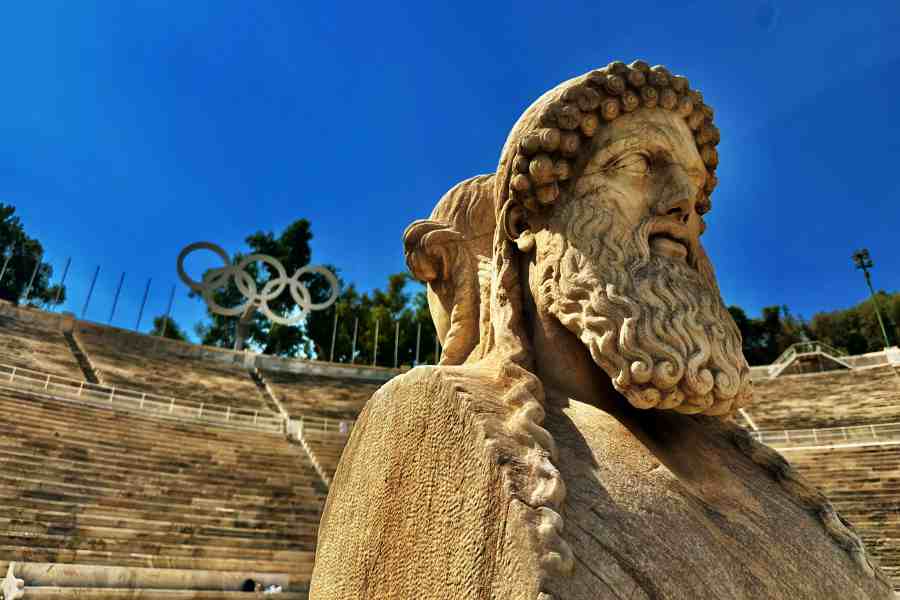Thu 08 August 2024:
The Greek historian Arrian (c. 86-160 AD) said he appreciated the glory of victory at an Olympic games, but also warned it was very difficult to achieve:
Do you wish to win an Olympic victory? So do I, by the gods! But consider the matters which come before that, and those which follow after, and only when you have done that, put your hand to the task.
Arrian listed the difficulties Olympic athletes had to face when preparing for the games:
You have to submit to discipline, follow a strict diet, give up sweet cakes, train under compulsion, at a fixed hour, in heat or in cold; you must not drink cold water, nor wine just whenever you feel like it; you must have turned yourself over to your trainer precisely as you would to a physician.
Arrian was not exaggerating. For ancient athletes, the path to Olympic glory was long and arduous, just like it is for modern athletes.
So, what was the experience like for ancient athletes training for and competing at the Olympics?
Ancient Olympic athletes had a hectic calendar.
The games at Olympia were not the only highly prestigious athletic contest in the ancient Greek world.
There were three other famous games where top athletes wanted to win – the Pythian games (celebrated every four years), the Nemean games (celebrated every two years), and the Isthmian games (celebrated every two years). Usually one or two of these games took place each year.
Together, these four games formed the “periodos” (circuit). If an athlete won prizes at all four games in a row, they were declared a “periodonikes” (circuit winner).
Athletes who achieved the feat of winning at all four of these prestigious games gained great fame.
Training for the games
Olympic athletes did everything they could to try to gain a competitive advantage.
The famous wrestler Milo of Croton – who flourished around 536-508 BC – had legendary training methods.
Milo ate huge amounts to retain his physical strength. Each day he “used to eat 20 minas (about 8.72kg) of meat, along with an equal amount of bread, and would drink three pitchers of wine”, according to Athenaeus of Naucratis (2nd century AD).
For physical conditioning, Milo would practice carrying around a newborn calf every day until it had grown into a bull.
Milo was not the only wrestler to train with animals. According to the historian Eusebius of Caesarea (4th century AD), Amesinas of Barca (victor in Olympic wrestling in 460 BC), used to train by wrestling bulls while he was tending his cattle. He even brought a bull with him to Olympia as a training partner.
What about nutrition – and sex?
There were many athletes who tried to achieve peak condition by testing special diets.
The runner Chionis of Sparta (mid 7th century BC) – who, according to the traveller Pausanias (2nd century AD), won seven Olympic victories (four in the “stadion” and three in the “diaulos”) – was renowned for training on a diet of dried figs.
Other victorious Olympic athletes, such as Eurymenes of Samos (6th century BC) and Dromeus of Stymphalus (5th century BC), favoured an all-meat diet.
According to Athenaeus of Naucratis, there was also a Theban athlete active during or before the 2nd century BC who “overpowered all his opponents by eating nothing except goat-meat”. We are not told this athlete’s name, but Athenaeus adds:
people made fun of the athlete because his sweat smelled bad.
Many Olympic athletes believed abstaining from sex gave them a competitive advantage.
Iccus of Tarentum, victor in the pentathlon in 476 BC, believed his abstention from sex was one of the reasons for his success: “during all the period of his training”, says the philosopher Plato (c. 429-347 BC), “he never touched a woman, nor yet a boy”.
Other Olympic victors famous for abstaining from sex were the runners Astylus of Croton (victorious in 488, 484, and 480 BC) and Crison of Himera (victorious in 448, 444, and 440 BC).
Following the rules at Olympia
Not just anyone was eligible to compete at the Olympics.
From 632 BC onwards, separate events were held at the Olympics for boy competitors (under 18) and adult male competitors.
The writer Philostratus of Athens (c. 170-250 AD) explains that a competitor for the boys’ events was eligible depending on
whether he has a tribe and a home city, whether he has a father and a family, whether he is of free birth and not illegitimate.
Adult male competitors similarly had to be citizens and free-born (not slaves).
Athletes competing at Olympia had to swear an oath to Zeus that for the ten months prior to the games they had “strictly followed the regulations for training”, as Pausanias tells us.
In the month prior to the Olympics, athletes had to reside at Elis preparing for the games.
There they were supervised by the Olympic judges – the “Hellanodikai” – notable for their purple robes and the forked rod they carried to beat athletes who broke the rules.
During this month, athletes worked out and competed in trial events. Those deemed substandard at the trial stages were not allowed to take part in the competition proper. In this month, the Olympic judges also decided who would compete against who in the games by drawing lots.
This black-figured amphora has one of the best surviving depictions of the long-jump event (the ‘halma’) at the ancient Olympic Games. #OlympicGames
The long jump was part of the pentathlon which combined five events held in the course of one afternoon. It differed from our… pic.twitter.com/wopco8Br2g
— Following Hadrian (@carolemadge) July 27, 2024
Competing
Each event at the Olympics was strictly overseen by the Hellanodikai.
If an athlete went against the rules, there were punishments. The athlete would be beaten by one of the judges with a rod, disqualified, or fined (or all three).
For example, the boxer Cleomedes of Astypalaea was famous for breaking the rules during a boxing match at Olympia in 496 or 492 BC and killing his opponent Iccus of Epidaurus. Pausanias tells us
on being convicted by the umpires of foul play and being deprived of the prize he became mad through grief and returned to Astypalaea.
In his rage at the outcome, Cleomedes used his immense strength to pull down a gymnasium in his hometown, and the collapse of the building killed some boys exercising there. He then went into hiding, eventually disappearing. He was later worshipped as a hero.
__________________________________________________________________________

https://whatsapp.com/channel/0029VaAtNxX8fewmiFmN7N22
__________________________________________________________________________
Winning and losing, then going home
Victorious athletes received olive wreathes in a presentation with the presiding officials.
This did not always go smoothly. Claudius Aelian tells the story that
an athlete from Croton, on winning at Olympia, went up to the presiding officials to receive his crown, and fell down dead from an attack of epilepsy.
Victorious athletes were so keen to announce their victories to their families that they sometimes went to extreme measures to do so.
When the long-distance runner Ageus of Argos won the “dolichos” event in 328 BC, he apparently ran all the way home from Olympia to Argos (some 150 km away) that same day to tell his people about his great victory – if we can believe the story.
Eventually, all victorious athletes returned to their hometowns and received a hero’s welcome. Fame and riches awaited them.
The losers licked their wounds and hoped to win next time.
Author:
![]()
Konstantine Panegyres
McKenzie Postdoctoral Fellow, researching Greco-Roman antiquity, The University of Melbourne
This article originally published in The Conversation click here
______________________________________________________________
FOLLOW INDEPENDENT PRESS:
WhatsApp CHANNEL
https://whatsapp.com/channel/0029VaAtNxX8fewmiFmN7N22
![]()
TWITTER (CLICK HERE)
https://twitter.com/IpIndependent
FACEBOOK (CLICK HERE)
https://web.facebook.com/ipindependent
YOUTUBE (CLICK HERE)
https://www.youtube.com/@ipindependent
Think your friends would be interested? Share this story!





